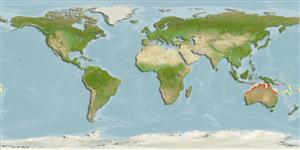Ikan bertulang rawan (sharks and rays) >
Carcharhiniformes (Ground sharks) >
Carcharhinidae (Requiem sharks)
Etymology: Carcharhinus: karcharos (Gr.), sharp or jagged; rhinus, an ancient name for sharks, from rhine (Gr.), rasp, both words alluding to a shark's jagged, rasp-like skin (See ETYFish); fitzroyensis: -ensis, Latin suffix denoting place: Fitzroy River, Queensland, type locality (See ETYFish).
Eponymy: This is a toponym; the holotype was collected in the estuary of the Fitzroy River, Western Australia. (Ref. 128868), visit book page.
More on author: Whitley.
Environment: milieu / climate zone / depth range / distribution range
Ekologi
laut; payau dasar (demersal); kisaran kedalaman 0 - 40 m (Ref. 6871). Subtropical; 10°S - 26°S
Western Pacific: northern Australia, from Western Australia to Queensland. Recorded in the Arafura Sea (Ref. 9819).
Length at first maturity / Size / Weight / umur
Maturity: Lm 94.5, range 89 - 100 cm
Max length : 135 cm TL jantan/; (Ref. 6871)
Duri punggung (Keseluruhan (total)) : 0; Duri dubur: 0. Bronze above, fading to grayish brown after death and in preserved specimens; light below, without conspicuous markings on fins; no conspicuous white band on flanks (Ref. 9997).
A little-known shark found inshore and offshore on the continental shelves from the intertidal to at least 40 m depth (Ref. 9997). Feeds mainly on teleost fishes, also crustaceans (Ref. 6871). Viviparous (Ref. 50449). Utilized for human consumption (Ref. 244, 9997) and probably for the oriental shark fin trade (Ref. 244).
Viviparous, placental (Ref. 50449). Females give birth to 1-7 pups every year between February and May (Ref. 6871). Size at birth about 50 cm (Ref. 6871). Distinct pairing with embrace (Ref. 205).
Compagno, L.J.V., 1984. FAO Species Catalogue. Vol. 4. Sharks of the world. An annotated and illustrated catalogue of shark species known to date. Part 2 - Carcharhiniformes. FAO Fish. Synop. 125(4/2):251-655. Rome: FAO. (Ref. 244)
Status IUCN Red List (Ref. 130435: Version 2024-1)
ancaman kepada manusia
Harmless
penggunaan manusia
Perikanan: nilai komersial kecil
Alat, peralatan
laporan khas
muat turun XML
Sumber internet
Estimates based on models
Preferred temperature (Ref.
123201): 26.1 - 28.7, mean 27.7 °C (based on 294 cells).
Phylogenetic diversity index (Ref.
82804): PD
50 = 0.5000 [Uniqueness, from 0.5 = low to 2.0 = high].
Bayesian length-weight: a=0.00331 (0.00184 - 0.00595), b=3.08 (2.93 - 3.23), in cm total length, based on LWR estimates for this species & Genus-body shape (Ref.
93245).
Trophic level (Ref.
69278): 4.1 ±0.6 se; based on size and trophs of closest relatives
Daya lenting (Ref.
120179): sangat rendah, Waktu penggandaan populasi minimum lebih dari 14 tahun (Fec=1).
Fishing Vulnerability (Ref.
59153): Very high vulnerability (81 of 100).
